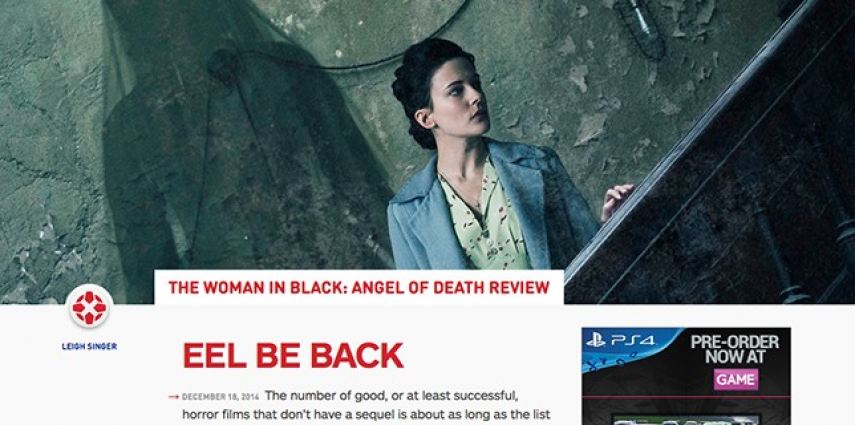The number of good, or at least successful, horror films that don’t have a sequel is about as long as the list of satisfied clients recommending the Michael Myers Babysitters Agency. So in 2012, when The Woman in Black, adapted from Susan Hill’s popular 1983 novel (and subsequent long-running West End play), became the biggest British horror hit of the past 20 years, a new chapter from the revamped Hammer Films was pretty much nailed on.
Horror sequels, perhaps more than most franchises, are generally the epitome of a quick cash-in. Even the classics – The Exorcist, Halloween, The Ring – regularly falter at the first follow-up, regurgitating the same old formula, minus the innovation. Credit Angel of Death, then, for at least trying to ring some changes on the original, even if ultimately its dependence on the now-known mythology and familiar tropes of its source material drag it kicking and screaming back to Black.
We don’t get another Victorian gothic drama, then, with star Daniel Radcliffe replaced by another Hogwarts classmate. Instead we open during the Blitz, 1941, as a bunch of young children leave bombed-out London town for the, heh-heh-heh, safety of the countryside. Unfortunately the vengeful spirit of Jennet Humfrye, the wronged suicide whose own son died, is still lurking about. At Eel Marsh House, you don’t need the German Luftwaffe to be in danger from things that go bump in the night.
Two teachers accompany the kids. Strict disciplinarian Mrs. Hogg (Helen McCrory) and the younger, kinder Eve Parkins (Phoebe Fox). It’s Eve who tries to connect with vulnerable young orphan Edward, and who first gets suspicious when Edward starts to exhibit trance-like behaviour; and when grisly things start happening to the other children. Eve, with the help of dashing and locally stationed RAF pilot Harry Burnstow (Jeremy Irvine), must fight back against their implacable ghostly foe.
For all the film’s admirable production qualities – George Steel’s images give the ever-present mist a creepy tactile quality and Jacqueline Abrahams’ production design on the dilapidated Eel Marsh House makes the Bates Motel look like the Beverly Wilshire – there’s something overly studied and box-ticked at play here. Screenwriter Jon Croker knows enough to ensure that both protagonists, Eve and Harry, need some unresolved past traumas that tie into the main storyline. He dutifully includes them but then proceeds – Eve’s tortured visions aside – to have characters tell each other their painful secrets, more than show them. It’s prose, all right, but there’s no poetry.
Those irritating LOUDJUMPSCARES, a feature of almost every modern horror flick generally having little to do with the actual plot, turn up on schedule every 10 minutes. And just once, it would be refreshing to see a ghost story where the door hinges were well oiled, the pipe work didn’t wheeze like an asthmatic and every kid’s plaything didn’t resemble a dog’s chew toy. Even the Angel of Death subtitle feels redundant. It’s a little like making a Jason Vorhees sequel called Friday 13th: Maniac with a Hockey Mask and Machete. Tell us something we don’t know, already.
Director Tom Harper (The Scouting Book for Boys, TV series Peaky Blinders) is one of the more promising young British helmers around, but it’s as if he knows that we already know the mysteries in store. One can feel him straining to keep things fresh, the camera constantly creeping in and around the old dark house. But the story, indeed the entire franchise has already been mortgaged to a property we’ve already seen condemned. There’s only so many renovations one can do.
It’s a shame because, if you get rid of the actual Woman in Black, there’s some promising material here. A tale set in WWII, a time where blackouts were mandatory, where death was ever-present and minds could snap at any time under the psychic strain, is fertile ground for horror. The best scenes here use these specifics: a fake airplane landing field location; a gruesome use for a gas mask; the repressed guilt of survivors. But inevitably, back to the house and its black widow we go, and it’s business as usual.
Earlier this year The Babadook showed how to transform a haunted house into something fresh and genuinely disturbing. And newcomer Phoebe Fox’s fine, tremulous performance suggests an actress who could dive into the depths of unfiltered grief. What we get here is a film that, despite its watery climax, paddles in the shallows, content to give us more easy Woman thrills, without really examining the horror of what makes us human.
The Verdict
By no means a disaster, The Woman in Black: Angel of Death’s very adequateness is its own cautionary tale. The need to keep a franchise breathing but stable, cuts off the new possibilities to make it come thrillingly alive.
6.0
Horror sequel that fails to match its predecessor in terms of scares.
+Impressive production elements
+Strong performance by Phoebe Fox
– Overfamiliar haunted house tropes
– Formulaic scares
– Wasted potential of intriguing new premise
The Woman in Black: Angel of Death reviewed by Leigh Singer for IGN.com http://uk.ign.com/articles/2014/12/18/the-woman-in-black-angel-of-death-review See the published article on IGN.com
